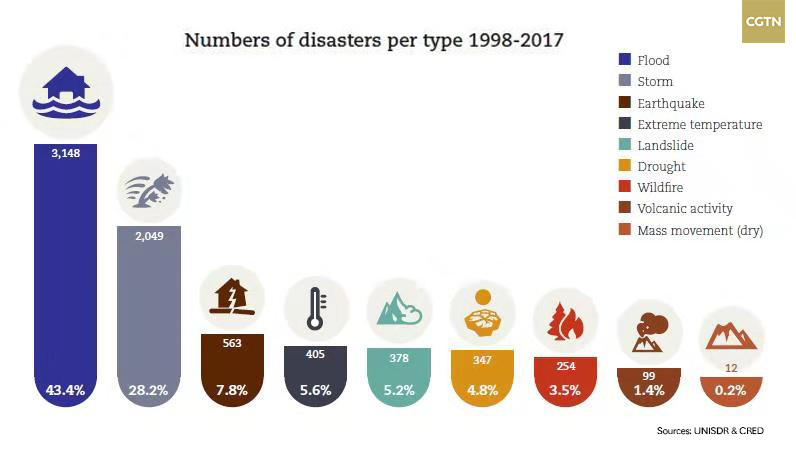
World
18:37, 30-Nov-2018
China, U.S. hit most as economic impact of climate-related disasters shoots up by 150%
Updated
17:47, 03-Dec-2018
By Abhishek G Bhaya

China and the U.S. have suffered the most losses due to climate-related disasters over the last two decades as the economic cost from such calamities hit 2.25 trillion U.S. dollars, an increase of more than 150 percent compared to the previous 20 years, according to a United Nations report released last month.
Ahead of the next week's COP24 Climate Change Conference in the Polish city of Katowice, the report titled "Economic Losses, Poverty & Disasters 1998-2017" - prepared jointly by the United Nations Office for Disaster Risk Reduction (UNISDR) and the Centre for Research on the Epidemiology of Disasters (CRED) at the Universite Catholique de Louvain in Belgium - also recommended integrating disaster risk reduction into investment decision as the most cos-effective way to reduce such risks.
"Investing in disaster risk reduction is therefore a precondition for developing sustainably in a changing climate," it emphasized.

The UNISDR-CRED report revealed that between 1998 and 2017, disaster-hit countries experienced direct economic losses valued at 2,908 billion dollars, of which climate-related disasters caused 2,245 billion dollars or 77 percent of the total.
This is up from 68 percent (895 billion dollars) of losses (1,313 billion dollars) reported between 1978 and 1997. Overall, reported losses from extreme weather events rose by 151 percent between these two 20-year periods.
The report showed that in absolute monetary terms, the U.S. recorded a loss of 944.8 billion dollars, the highest among all the countries, followed by China which incurred a loss of 492.2 billion dollars. This, despite China suffering a significantly higher number of disasters than the U.S. – 557 compared to 482.
Japan, India, Puerto Rico, Germany, Italy, Thailand, Mexico and France make the top 10 countries/territories, in that order, to have faced the economic brunt of climate-related disasters.

Of these, Puerto Rico is the only one to also figure among the top 10 countries/territories with highest average annual percentage losses relative to its gross domestic product (GDP). The Caribbean island territory witnessed an average of 12.2 percent of its total annual GDP over the last 20 years destroyed due to disasters, placing it only behind Haiti with a loss of 17.5 percent.
The Democratic People's Republic of Korea (DPRK), Honduras, Cuba, El Salvador, Nicaragua, Georgia, Mongolia and Tajikistan are the other countries/territories that saw a substantial portion of their GDP washed away in such disasters.

Burden on the poor
Throwing some light on absolute losses relative to the burden on the poor, the findings reveal that inequality is even greater than available losses data suggest because of systematic under-reporting by low-income countries.
While high-income countries reported losses from 53 percent of disasters between 1998 and 2017, low-income countries only reported them from 13 percent of disasters.
Therefore, no data on losses are available for nearly 87 percent of disasters in low-income countries.

"The report highlights the ever widening 'protection gap' that exists between rich and poor across the planet. It is often said that those who suffer the most from climate change are those who contribute least to it. We are acutely reminded that disasters are a combination of hazard, exposure and vulnerability," UN secretary general's special representative for disaster reduction, Mami Mizutori and CRED Professor Debabarati Guha-Sapir said in a jointly written foreword for the report.
While evaluating the human loss in climate-related and geophysical disasters, the report disclosed that over the last 20 years such calamities killed 1.3 million people and left a further 4.4 billion injured, homeless, displaced or in need of emergency assistance.

While the majority of fatalities were due to geophysical events, mostly earthquakes and tsunamis, 91 percent of all disasters were caused by floods, storms, droughts, heatwaves and other extreme weather events.
Also georeferencing the disasters since 2000, the UNISDR-CRED report showed that in low-income countries, an average of 130 people died per million living in affected areas, compared to just 18 in high-income countries. This indicated "that people exposed to natural hazards in the poorest nations were more than seven times more likely to die than equivalent populations in the richest nations," it stated.

"Such data demonstrates that while absolute economic losses might be concentrated in high-income countries, the human cost of disasters falls overwhelmingly on low and lower-middle income countries: vulnerability to risk and degrees of suffering are determined by levels of economic development, rather than simple exposure to natural hazards per se," it said.
"The report's analysis makes it clear that economic losses from extreme weather events are unsustainable and a major brake on eradicating poverty in hazard exposed parts of the world," Mizutori said in a statement.
(Cover Photo: A graphic representation show the cost of climate-related disaster increasing nearly 151 percent from an estimated 895 billion U.S. dollars during 1978-1997 to 2.25 trillion U.S. dollars during 1998-2017. /Photo via Statista)

SITEMAP
Copyright © 2018 CGTN. Beijing ICP prepared NO.16065310-3
Copyright © 2018 CGTN. Beijing ICP prepared NO.16065310-3